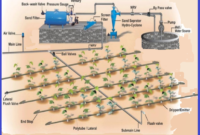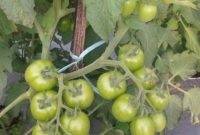Drip irrigation is modern technique. It is also called trickle irrigation, which was originally developed in Israel in the early 1960s and became popular in areas of water scarcity. The drip irrigation is the most competent and it can be practised in array of crops, especially in vegetables, orchard crops, flowers and plantation crops (Mamata Swain, 1999).
Drip irrigation was used to the ancient custom in certain parts of India of irrigating a tulsi plant kept in the courtyard. During the summer months, the plant was irrigated by a hanging pitcher containing water and a minute hole at its bottom to allow the trickling of water on to the plant. The tribal farmers of Arunachal Pradesh practised a primitive form of drip irrigation system using a slender bamboo as the conduit for water flow. The use of drippers in sub-surface irrigation network was first experimented in Germany in 1869. The noticeable growth of the petrochemical industry during and after the 1950s aided manufacturing of plastic pipes at a cost much cheaper than the cost of metallic or cement concrete pipes. Plastic pipes are convenient for water conveyance under pressure and the plastic material are easily formed into the desired configuration. These features of plastic made the field-scale use of drip irrigation practicable. The drip system was developed for field crops in Israel in the early 1960s and in Australia and North America in the late 1960s. The area under drip irrigation system in the USA is about 1 M ha, followed by India, Spain, and Israel. In India, there has been a tremendous growth in the area under drip irrigation during the last 15 years. At present, around 3.51akh ha area is under drip irrigation with the efforts of the Government of India, while it was only 40 ha in 1960. Maharashtra (94,000 ha), Karnataka (66,000 ha) and Tamil Nadu (55,000 ha) are some of the states where large areas have been brought under drip irrigation. Many crops are irrigated by the drip method in India with the tree crops occupying the maximum percentage of the total area under drip irrigation, followed by vine crops, vegetables, field crops, flowers and other crops.

In drip irrigation, water is applied near the plant root through emitters or drippers, on or below the soil surface. The soil moisture is kept at an optimum level with frequent irrigations. In this method irrigation water is conveyed on the surface in 12 to 16 mm diameter tubing’s fed from large feeder pipes. The water is allowed to drip or trickle slowly through the nozzle or orifices at practically zero pressure. In this way the soil in the root-zone of crops is constantly kept wet. Drip irrigation results in a very high water application efficiency of about 90-95 per cent.
The area under drip irrigation system in the USA is about 1 M ha, followed by India and other countries.
Major component of drip irrigation:
- Pump station
- By pass assembly
- Control valves.
- Filtration system
- Fertilizer tank/venturi
- Pressure gauge
- mains/Sub mains
- Laterals
- Emitting devices
- Micro tubes.
Pump station takes water from the source and provides the right pressure for delivery into the pipe system.
Control valves control the discharge and pressure in the entire system.
Filtration system cleans the water. Common types of filter include screen filters and graded sand filters which remove fine material suspended in the water.
Fertilizer tank/venturi slowly add a measured dose of fertilizer into the water during irrigation. This is one of the major advantages of drip irrigation over other methods.
Mainlines, submains and laterals supply water from the control head into the fields. They are usually made from PVC or polyethylene hose and should be buried below ground because they easily degrade when exposed to direct solar radiation. Lateral pipes are usually 13-32 mm diameter.
Emitters or drippers are devices used to control the discharge of water from the lateral to the plants. They are typically spaced more than 1 metre apart with one or more emitters used for a single plant such as a tree. For row crops more closely spaced emitters may be used to wet a strip of soil. Many different emitter designs have been produced in recent years. The basis of design is to produce an emitter which will provide a specified constant discharge which does not vary much with pressure changes, and does not block easily.
In India, there has been a fabulous growth in the area under drip irrigation during the last many years. At present, major area is under drip irrigation with the help of the Government of India. Reports indicated that Maharashtra (94,000 ha), Karnataka (66,000 ha) and Tamil Nadu (55,000 ha) are some of the states where large areas have been brought under drip irrigation. Many crops are irrigated by the drip method in India with the tree crops occupying the maximum percentage of the total area under drip irrigation, followed by vine crops, vegetables, field crops, flowers and other crops.

The advantages of drip irrigation are under:
- Possibility of using soluble fertilizers and chemicals.
- Fertilizer and nutrient loss is minimized due to localized application and reduced leaching.
- Water application efficiency is high.
- Field levelling is not necessary. Fields with irregular shapes are easily accommodated.
- Recycled non-potable water can be safely used.
- Soil type plays less important role in frequency of irrigation.
- Soil erosion is lessened.
- Weed growth is lessened.
- Water distribution is highly uniform, controlled by output of each nozzle.
- Labour cost is less than other irrigation methods.
- Variation in supply can be regulated by regulating the valves and drippers.
- Plants remains dry, reducing the risk of disease.
- Usually operated at lower pressure than other types of pressurised irrigation, reducing energy costs.
The shortcomings of drip irrigation are:
- Initial cost can be more in this technique.
- The sunrays can affect the tubes used for drip irrigation, shortening their usable life.
- If the water is not properly filtered and the equipment not suitably maintained, it can result in blockage.
- For subsurface drip the irrigator cannot see the water that is applied. This may lead to the farmer either applying too much water (low efficiency) or an insufficient amount of water, this is particularly common for those with less experience with drip irrigation.
- Drip irrigation might be inadequate if herbicides or top dressed fertilizers need sprinkler irrigation for activation.
- Drip tape causes extra clean-up costs after harvest. Users need to plan for drip tape winding, disposal, recycling or reuse.
- Waste of water, time and harvest, if not installed properly. These systems require careful study of all the relevant factors like land topography, soil, water, crop and agro-climatic conditions, and suitability of drip irrigation system and its components.
- In lighter soils subsurface, drip may be unable to wet the soil surface for germination. Requires careful consideration of the installation depth.
One of the main purposes of drip irrigation is to decrease the water consumption by reducing the leaching factor. However when the available water is of high salinity or alkalinity, the field soil becomes gradually unsuitable for cultivation due to high salinity or poor infiltration of the soil. Consequently, drip irrigation converts fields in to fallow lands when natural leaching by rain water is not adequate in semi-arid and arid regions.
Most drip systems are designed for high efficiency and have little or no leakage. Without sufficient leaching, salts applied with the irrigation water may build up in the root zone. On the other hand, drip irrigation avoids the high capillary potential of traditional surface-applied irrigation, which can draw salt deposits up from deposits below. Drip irrigation systems cannot be used for damage control by night frosts.
